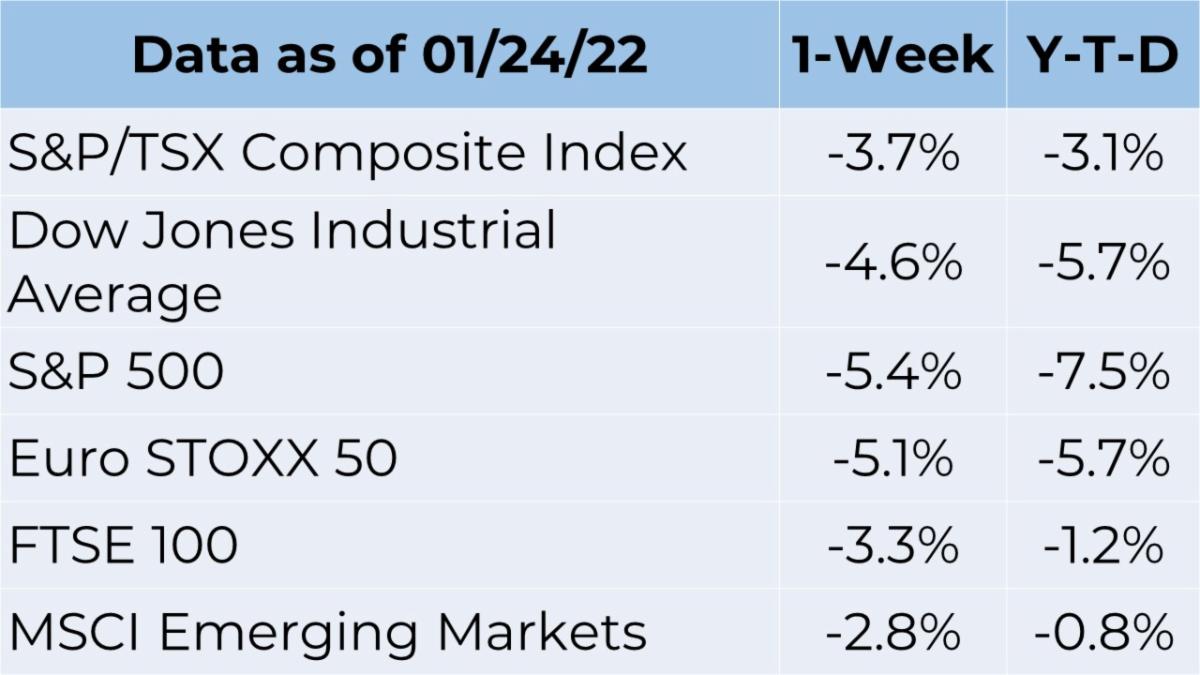Weekly Market Commentary January 26th 2022
The Markets
It’s widely recognized that people do not make perfect financial decisions. In fact, many investors rely on mental shortcuts when asked to make complex decisions. That may be why there are theories that correlate stock market performance to football, hemlines and sales of headache remedies.
For example, last week several articles about the stock market used the adage, “As goes January, so goes the year.” The saying describes the January Barometer, which holds that the performance of the S&P 500 index in January has predictive value. If stocks gain in January, then the index may gain over the full year. If stocks decline in January, then the index may suffer losses over the full year.
“The January Barometer, in fact, fails real-time tests at the 95 percent confidence level that statisticians often use when determining whether a pattern is genuine. Since 1972 its track record is indistinguishable from a random pattern,” wrote Mark Hulbert in MarketWatch.
You don’t have to look far to find flaws in the pattern.
In 2021, the S&P 500 fell during the month of January and gained 26.8 percent over the full year. The same thing happened in 2020. The S&P 500 declined in January and finished the year with a gain of more than 16 percent. Perhaps this phenomenon will one day be known as the “Pandemic Exception.”
The real takeaway from the past two years isn’t that the January Barometer is flawed, it’s that the U.S. economy, companies and financial markets have proven to be quite resilient.
Last week, major U.S. stock indices moved lower on uncertainty about inflation, the pandemic and Federal Reserve policy, reported Mark DeCambre of MarketWatch. The Dow Jones Industrial Average declined 4.6 percent, the S&P 500 was down 5.7 percent, and the S&P/TSX Composite index was down 2.7 percent.
The news wasn’t all negative, however, as several European nations removed pandemic-related restrictions, including the United Kingdom, which scrapped the majority of its restrictions, including plans to implement a vaccine passport, as well as social distancing, testing, and masking requirements.
At the same time, the WHO has recommended that countries remove travel restrictions, noting that these restrictions have been ineffective, while continuing to “contribute to the economic and social stress experienced by citizens.” As well, additional measures that countries implement, such as testing, vaccination requirements and quarantining “should be based on risk assessments to avoid placing an excessive financial burden on international travelers.”
Hopefully, as more countries open up, we will be able to reverse course on the damage caused by supply chain disruptions. If you have any questions or concerns about your investment portfolio or recent market events, please don’t hesitate to give us a call.

Source: FactSet
Watch our most recent videos:
Which country is the most innovative?
The silver lining of the pandemic may be found in innovation, which has flourished as companies, economies and countries have adapted to difficult circumstances.
The Global Innovation Index (GII) tracks 80 indicators that inform innovation. The indicators are grouped into seven categories:
- Institutions: Political, regulatory and business environments.
- Human capital and research: Education and research and development.
- Infrastructure: Information and communication technologies, general infrastructure and ecological sustainability.
- Market sophistication: Credit, investment, trade, diversification and market scale.
- Business sophistication: Knowledge workers, innovation linkages and knowledge absorption.
- Knowledge and technology outputs: Knowledge creation, impact and diffusion.
- Creative outputs: Intangible assets, creative goods and services, and online creativity.
In 2021, the top-three innovative countries by income group were:
High-income countries
No. 1. Switzerland, with strength in knowledge and technology outputs, infrastructure and creative outputs.
No. 2. Sweden, with strength in business sophistication, human capital and research, and knowledge and technology outputs.
No. 3. United States, with strength in knowledge and technology outputs and market and business sophistication
Upper-middle income countries
No. 1. China, with strength in knowledge and technology outputs and business sophistication.
No. 2. Bulgaria, with strength in knowledge and technology and creative outputs.
No. 3. Malaysia, with strength in knowledge and technology outputs and market sophistication.
Lower-middle income countries
No. 1. Vietnam, with strength in market sophistication and creative outputs.
No. 2. India, with strength in knowledge and technology outputs and market sophistication.
No. 3. Ukraine, with strength in knowledge and technology outputs and human capital and research.
Low-income countries
No. 1. Rwanda, with strength in institutions and business sophistication.
No. 2. Tajikistan, with strength in knowledge and technology outputs and market sophistication.
No. 3. Malawi, with strength in knowledge and technology outputs and market sophistication.
Switzerland, Sweden, the United States, the United Kingdom and South Korea were the most innovative countries in the world, overall. China was the only middle-income economy among the top 30 most innovative economies in the world.
Weekly Focus - Think About It
“If you have urgent current expenses to cover, then future priorities like college and retirement fall off your radar because they are simply less pressing. Scarcity of attention prevents us from seeing what's really important. The psychology of scarcity engrosses us in only our present needs.”
—Sendhil Mullainathan, University of Chicago professor and author
Eric Muir
B.Comm. (Hons.), CIM®, FCSI
Portfolio Manager
Tracey McDonald
FCSI, DMS, CIM®
Portfolio Manager
Derek Lacroix
BBA, CIM®, CFP®
Associate Financial Advisor
P.S. Please feel free to forward this commentary to family, friends, or colleagues. If you would like us to add them to the list, please reply to this email with their email address and we will ask for their permission to be added.

